Curse of the Wymer Stones is a one-verus-many dungeon crawler. Up to four people will play as the Adventurers, while one person takes on the role of the Cursed Dwarves. It’s a game that’s easy to teach and play, and with some adult supervision, can be family-friendly enough to be played with your kids.
Adventurers will wander through the dungeon, encountering Locks, Traps, Relics, and, eventually, the Wymer Stones. There’s one Wymer Stone per Adventurer and, once claimed, they spawn a Cursed Dwarf onto the board to try and turn the Adventurers into soulless Wraiths.

Each side will have their own six-sided die (d6), which will see a lot of action throughout the game. Adventurers will roll-off against the Cursed Dwarves player for each Lock and Trap, as well as battles with one another.
If the Adventurers find all their Wymer Stones and defeat the Cursed Dwarves in battle, the Adventurers win. If the Cursed Dwarves defeat all the Adventurers in battle, turning them all into Wraths, the Cursed Dwarves win.
Setup
Unfold the board and set it within easy reach of all players. Decide who will play the Adventurers and who will play the Cursed Dwarves, giving each the player cards for their characters and the matching character stands. Adventurers will have two character stands, one with their character’s image surrounded by a green glow. Set this one aside for the moment. Place the other Adventurer on their matching color’s Wymer Stone icon on the board.
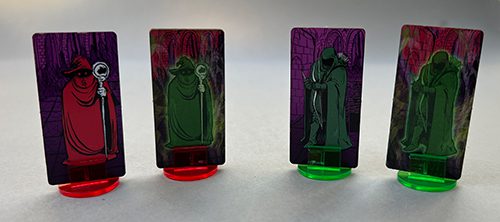
Shuffle and set out the three decks of cards (Traps, Relics, and Wraith) and set them close to the Adventurers.
Give the Cursed Dwarf player the chits for the Locks and set them aside for the moment. Then give them all the chits for the Locks, Traps, Relics, and the Wymer Stones matching the colors of the Adventurers playing. All players should agree on a difficulty level; the Cursed Dwarf player then selects the number of Relics and Traps matching the difficulty level, leaving the rest aside to be added to the game later.

The Cursed Dwarf player then sets the locks on squares in narrow passageways where they cannot be avoided. The Traps, Relics, and Wymer Stones are placed Question Mark side up on any open squares.
Playing the Game
Each Adventurer’s character card shows the number of steps they may take on a turn in the upper left corner. As well, each Adventurer has a special power they can activate on a successful roll of a d6. The three horned skull icons at the bottom of their character card represent their three hit points. (More on those later.)
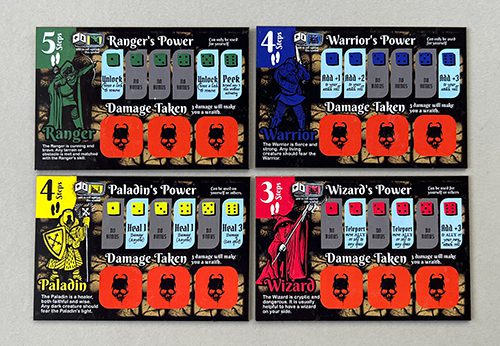
An Adventurer’s turn starts with a roll to see if their character’s special power activates for that turn. Characters fall into four different classes, each with their own special power that can be activated on a successful roll at the start of their turn: Ranger (removes locks); Warrior (bonus on Attacks); Paladin (heal damage taken); and Wizard (Teleport within the dungeon).
After the roll, the Adventurer can move up to their allotted number of steps.
All players will move around the dungeon orthogonally, from square to square. The many exceptions to this are the fuchsia ovals scattered throughout the board. These are portals that allow you to teleport to any other portal on the board. (Each step here costs one movement point, so entering one portal and exiting another takes two movement points.)

During the course of movement, an Adventurer will either cross over and/or land on a chit on the board. Locks must be attacked immediately with a d6 roll-off against the Cursed Dwarves. The player with the higher roll (with ties going to the Cursed Dwarves) wins. If the Adventurer wins, the Lock chit is removed from the board; if Cursed Dwarves win, the Adventurer must wait until their next turn to attack the Lock again.
Question Mark chits (Traps or Relics) do not need to be resolved right away, but must be resolved in the order they were encountered. If it’s a Trap, the Adventurer draws a card from the Trap deck and rolls against the Cursed Dwarves. Trap cards have two text boxes, one for a successful roll, and another for an unsuccessful roll.
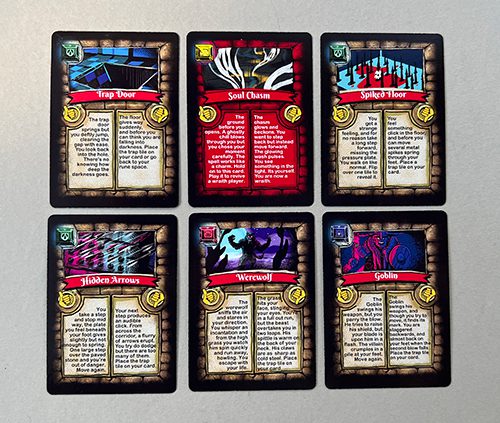
The player will read out whichever side applies to their roll and follows through with the written ramifications.

When a player turns over a Relic chit, they take a card from the Relic deck and add it to their player card. These are one-time use cards, frequently boosting any Attack.
If an Adventurer fails a roll against a Trap, they’ll most likely take the Trap chit and add it to the bottom of their player card. If an Adventurer takes three such hits, their character dies and becomes a Wraith.
Wraiths are limited to two movement actions, but may continue to move through portals and, thanks to their incorporeal status, dungeon walls. Their goal is to return to their starting position on the board to become reborn and fight again.
Adventurers must each search amongst the Traps and Relics for their Wymer Stones. Once found, a Cursed Dwarf is added to the board and may begin attacking the Adventurers. While a Cursed Dwarf may attack any Adventurer, only those Adventurers who have claimed their Wymer Stone may attack a Cursed Dwarf. Adventurers without their Wymer Stone can only hope to deflect the blows a Dwarf may mete out.
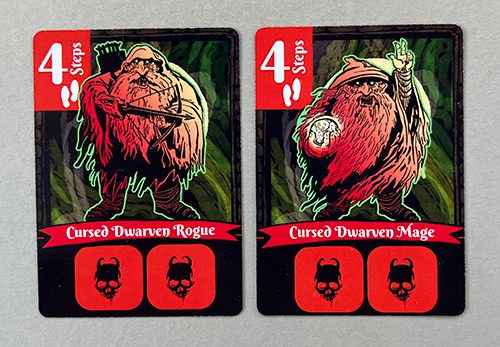
After all Adventurers and Cursed Dwarves have taken their turns, the Cursed Dwarf player adds another Lock anywhere on the board, along with two Trap or Relic chits. Then the next round of turns begin.
The Adventurers win if they have found all their Wymer Stones and defeated all the Cursed Dwarves in battle. The Cursed Dwarves win if all the Adventurers have been defeated and turned into Wraiths at the end of a turn.
Thoughts
Unfortunately, The Curse of the Wymer Stones fell flat for me in our playthroughs. I had a number of issues with the game that failed to improve with each replay.
The key to a successful one-versus-many game (or any game, really) is player engagement. Whether it’s in a social deduction setting where people are trying to detect the actions of a single player (Whitehall Mystery, Rear Window) or abstract strategy games where one player has fewer pieces than their opponent (Hnefatafl, Fox and Geese), everyone playing needs to feel a sense of agency in their actions in the game. For me, this was missing in The Curse of the Wymer Stones.
For most of the games where I played as the Cursed Dwarves, I did nothing but set up the board, roll a d6 against Traps and Locks, and add three chits to the board at the end of each round. Since a Dwarven character only enters the board after an Adventurer claims their color-matching Wymer Stone, there’s next to no active engagement for the Dwarves player until that happens. And that can take over half the game.
Once the Dwarves enter the board (one at a time, remember), they do so with only two hit points. Adventurers, on the other hand, have three hit points, plus any Relic bonuses they gain, making them much harder to kill and turn into a Wraith.
The game also suffers from a predictability that eliminates much of the tension a game needs to remain interesting. Adventurers will move to encounter Trap/Relic chits on each turn, seeking the Wymer Stones. Dice will be rolled. Then it’s on to the next player who does the same thing.
This isn’t helped by the number of portals across the board. A player can easily make it from one side of the board to another in just a few steps. This also means that, with few expectations, an Adventurer can find a path around Locks to access a chit.
We also discovered that we ran through the Trap deck on more than one occasion. Given the number of Traps in the game, I’m surprised there weren’t more cards in the deck. Adding some cards that, on a fail, would inflict two hit points of damage would help increase the tension.
For me, The Curse of the Wymer Stones needs additional refinements. The Cursed Dwarves need to have more hit points (closer to six) and more presence in the game. (Perhaps moving every other turn until the first Wymer Stone is claimed.) If you also cut the number of portals by two-thirds of those on the board now, this would not only give the Dwarven player more skin (hide?) in the game, but it would make them a serious threat that Adventurers would need to plan around to avoid. (Or Attack if they were feeling lucky.)
Despite my issues with the game, I do think Curse of the Wymer Stones would work as a family game, providing a parent played the role of the Cursed Dwarves and let the kiddos play as the Adventurers. That would give the youngsters a chance to work out some simple dungeon-crawling strategies and have a d6 of a chance to win their Attacks. Some of the text on the Trap cards might be a bit much for very young players, so having an adult read and paraphrase when necessary might be a good idea.
One last thing: if you’re of a certain age, does the Red Wizard character look familiar?
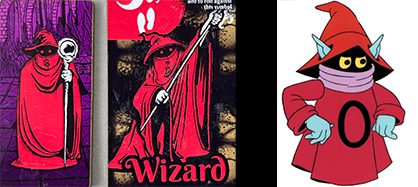


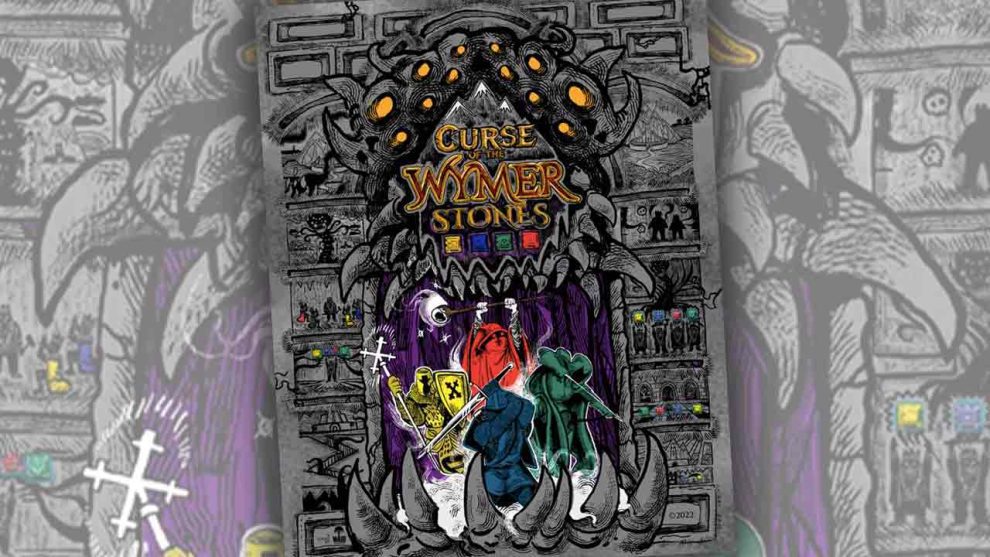


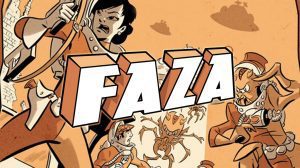






Add Comment